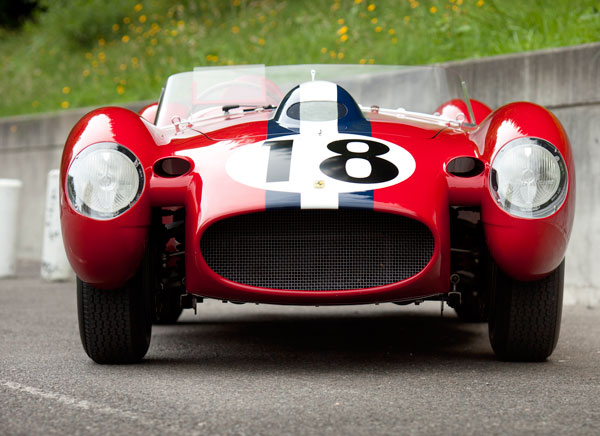Chassis Number: 0666 TR
Chassis number: 0666 TR
The development of the Ferrari 250 TR began in early 1957 with the car presented here, 0666 TR, which has the distinction of serving as the first prototype for the 250 Testa Rossa series.
0666 TR made its debut at the Nürburgring 1,000 Km, coming 6th in qualifying and 10th in the race. It then underwent development and appeared at the Swedish Grand Prix equipped with an experimental 3.1-liter engine, but this gave out, and the car retired.
Between September and October 1957, 0666 TR was stripped of its envelope body and refinished by Scaglietti in the quintessential pontoon-fender style. At that time, the prototype received its definitive driveline, complete with the Tipo 128 LM Testa Rossa motor and 4-speed gearbox.
This car then participated in the Venezuelan Grand Prix, coming in 3rd overall, before being transported to Argentina for the first race of the 1958 season, the Buenos Aires 1000 Km, finishing 2nd overall. The Targa Florio was the last outing for 0666 TR as a Scuderia Ferrari team car. It was in 4th place when it retired.
In June 1958, 0666 TR was sold to Luigi Chinetti and delivered to him at Le Mans to be driven by Dan Gurney and Bruce Kessler. At around 10 pm in the rain, Kessler collided with a privately entered D-type Jaguar, resulting in a fire and the Testa Rossa’s subsequent retirement.
The incident required a factory rebuild and a fresh pontoon-fender body from Scaglietti. By the beginning of 1959, Chinetti realized that 0666 TR would not be competitive, and it was sold to Rod Carveth, a Californian privateer who entered it for the 12 Hours of Sebring, where it retired. The same fate awaited Carveth and 0666 TR at the Nürburgring 1000 Km. In June the Ferrari traveled to Le Mans, where the engine failed on the Mulsanne straight. At Laguna Seca, Phil Hill drove 0666 TR but it didn’t qualify.
In June 1962, Carveth offered the car for sale. Enter 0666 TR’s fourth owner, Bev Spencer, a local Buick dealer who used it as his personal street car until his new 250 GTO arrived.
After the original engine finally gave out, it was removed and traded to Pete Lovely. When its then-owner believed the aging Ferrari was worth more in cash than as a car, he doused the interior in gasoline and set it on fire. While it was enough to collect the insurance money, the result was little more than a superficial burn. In 1970, Charles Betz and Fred Peters purchased the Testa Rossa. Over the next decade, 0666 TR was restored to a show-quality standard using an appropriate engine from 0724 TR.
By the late 1980s, the restoration was complete, and 0666 TR began collecting concours awards. In 2002, Betz and Peters sold it to the current caretaker, a preeminent collector, who commissioned Dennison International to complete a restoration that would bring 0666 TR back to its original team-car appearance and specification. Instrumental to this project was a significant acquisition: the original, matching-numbers engine and a correct rear differential.
The freshly restored prototype 250 TR made its debut at the 2006 Pebble Beach Concours d’Elegance and earned a First in Class. At the Cavallino Classic, it took an FCA Platinum Award and the TR Cup. At the 2007 Ferrari Club of America Meet, it received the Coppa Bella Macchina, the Coppa GT and its second Phil Hill Award.
With its prototype status, exquisite beauty, proud race record and uncommon authenticity, 0666 TR must be considered one of the great Ferrari sports racing cars.

